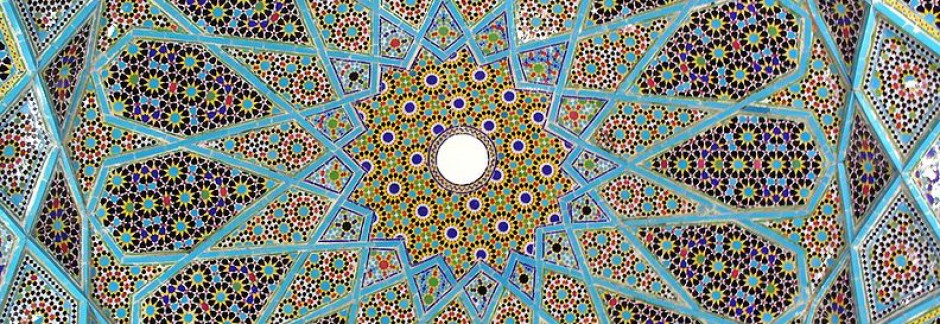Hafez excelled in the ghazal which is the most important lyrical form in Persian poetry. It is typically composed of 7 to 14 couplets called beyts, with a rhyme scheme of aa, ba, ca, da, etc., and is based on a quantitative meter. The poet generally “signs” his poem with his nom de plume, or takhaloss.
Hafez’s work represents a brilliant culmination of a tradition that had been developing for several hundred years before him. He is considered the most original and interesting of the ghazal poets. Like the great Saadi and most other ghazal poets, Hafez was a court poet whose treatment of the ghazal is largely determined by rhetorical convention. It is within the strictures of these conventions that he excels as an original poet because of a unique artistic and spiritual genius.
The ghazal largely developed as a panegyric in praise of the patron, but could also address and refer to a wide range of subjects. The object of address is always an idealized figure whether king, minister, earthly or divine beloved- male or female, wine bearer, the murshid or some combination or conflation of these possibilities. The object of address may even change within a given ghazal.
There are special possibilities for ambiguity in Persian as it does not indicate gender by pronoun or inflection, and is not capitalized. And because the ghazal draws on a set stock of conventional figures and motifs to describe an idealized subject, the identity of the object of address can often only be established by context, if at all. In the case of Hafez, the paramount problem in encountering his poetry is identifying the object of address as one of several possibilities. This holds true even if, for example, he is regarded as a “spiritual poet”. Who is the beloved? Is there more than one beloved? Is the beloved a man or woman? Is the idealized beloved such by reason of conventional figure, or because the beloved is in fact a divine beloved in the form of a person?
This translator has adopted the assumption that for Hafez love is a continuum in which idealized human love often, and perhaps as a rule in his ghazals, refers to an embodied divine beloved who appears in different guises, and is often conflated with other identities, notably the putative object of address, the royal patron. Why would this be so?
Islam is an exoteric religion with profound spiritual possibilities but which are rarely revealed as such. The Prophet is considered an “ordinary man,” for example. It is considered heretical to worship him, much less equate him with God. But within Islam is a rich tradition of Masters who deem him the very presence of God on earth, and who themselves represent the same. Spiritual tradition avers that Hafez was such a Master, and that his Divan is largely about, and dedicated to, his Master, in the context of traditional court poetry. But he couldn’t boldly claim this! The zealous traditionalists of Islam were as ubiquitous then as now!
Finally, this brings us to the discussion of wine and its metaphorical possibilities in Hafez’s poetry. Wine is prohibited by Islam but was common to the courts. Hafez, like many other Sufi poets, uses the image of wine to indicate intoxication with the Beloved’s attributes, while enjoying and praising royal vintage as part of his role as a court poet, as well.


My wife made me aware of your site today.
Thank you for your sharings about Hafez, and concerns of the Trust members. May we do our part in uncovering Baba’s truth! in His Love.
Jai Meher Baba!